#bootstrap tutorial for beginners
Explore tagged Tumblr posts
Text

Bootstrap Car Repair Website
#car repair website#html css#divinector#frontenddevelopment#css#css3#html#learn to code#webdesign#website design#bootstrap website design#responsive website design#bootstrap tutorial for beginners#create a website#make a website
0 notes
Text
Bootstrap 4 Tutorial for Beginners: Learn the Basics of Responsive Web Development

If you’re new to web design and development, Bootstrap 4 is the perfect tool to help you get started. It’s a free, open-source framework that makes creating responsive and visually appealing websites quick and easy. With Bootstrap 4, you don’t need advanced coding skills – the framework does the heavy lifting for you!
One of the standout features of Bootstrap 4 is its grid system, which allows you to create layouts that adapt beautifully to different screen sizes. Whether you’re building a website for desktops, tablets, or smartphones, Bootstrap ensures your content looks great everywhere.
Bootstrap 4 also includes a wide variety of components, such as navigation bars, buttons, modals, and forms. These pre-designed elements save you time and effort, allowing you to focus on customizing the look and feel of your website.
Another reason Bootstrap 4 is ideal for beginners is its built-in utilities, which make styling easier. With simple classes, you can adjust spacing, alignment, colors, and more without writing complex CSS.
Getting started with Bootstrap 4 is simple. All you need is basic HTML knowledge, and you’re ready to dive in. Many online tutorials and resources are available to guide you step by step.
If you’re ready to create stunning, responsive websites, explore more with the Bootstrap Tutorial for Beginners at Tutorial and Example. Happy learning!
0 notes
Text

Boost your web design skills with our Bootstrap 4 tutorial for beginners! Learn to create responsive, professional websites easily using Bootstrap's grid, components, and utilities. Perfect for aspiring developers and designers. Start your journey today!
0 notes
Text
Mastering Web Development: A Comprehensive Guide for Beginners
In the vast landscape of technology, web development stands as a crucial cornerstone. It encompasses the art and science of building websites, ranging from simple static pages to complex web applications. Whether you're aiming to pursue a career in software development or seeking to enhance your digital presence, understanding web development is essential.
In this comprehensive guide, we'll take you through the fundamental concepts and practical skills needed to master web development from scratch. Let's dive in!
1. Understanding HTML (Hypertext Markup Language)
HTML serves as the backbone of every web page, providing the structure and content. It uses tags to define different elements such as headings, paragraphs, images, and links. By mastering HTML, you'll be able to create well-structured and semantically meaningful web documents.
2. Exploring CSS (Cascading Style Sheets)
CSS is the language used to style HTML elements, enhancing their appearance and layout. With CSS, you can customize colors, fonts, spacing, and more, giving your website a polished and professional look. Understanding CSS selectors and properties is essential for effective styling.
3. Introduction to JavaScript
JavaScript is a versatile programming language that adds interactivity and dynamic behavior to web pages. From simple animations to complex web applications, JavaScript powers a wide range of functionalities. Learning JavaScript fundamentals such as variables, functions, and events is crucial for web development.
4. Building Responsive Websites
In today's mobile-centric world, it's essential to create websites that adapt seamlessly to various screen sizes and devices. Responsive web design achieves this by using fluid grids, flexible images, and media queries. Mastering responsive design principles ensures that your websites look great on desktops, tablets, and smartphones.
5. Introduction to Version Control with Git
Git is a powerful tool for tracking changes in your codebase and collaborating with other developers. By learning Git basics such as branching, merging, and committing, you can streamline your development workflow and effectively manage project versions.
6. Introduction to Front-End Frameworks
Front-end frameworks like Bootstrap, Foundation, and Materialise provide pre-designed components and stylesheets to expedite web development. By leveraging these frameworks, you can create responsive and visually appealing websites with less effort and code.
7. Introduction to Back-End Development
While front-end development focuses on the user interface, back-end development deals with server-side logic and database management. Learning back-end languages such as Node.js, Python, or PHP enables you to build dynamic web applications and handle user interactions efficiently.
8. Deploying Your Website
Once you've developed your website, it's time to make it accessible to the world. Deploying a website involves selecting a web hosting provider, uploading your files, and configuring domain settings. Understanding the deployment process ensures that your website goes live smoothly.
9. Conclusion and Next Steps
Congratulations on completing this comprehensive guide to mastering web development! By now, you've gained a solid understanding of HTML, CSS, JavaScript, version control, frameworks, and deployment. As you continue your journey in web development, remember to stay curious, practice regularly, and explore advanced topics to further refine your skills.
Resources for Further Learning:
Online tutorials and documentation
Interactive coding platforms
Community forums and discussion groups
Next Steps:
Explore advanced topics such as web performance optimization, server-side rendering, and progressive web apps.
Build real-world projects to apply your skills and showcase your portfolio.
Stay updated with the latest trends and technologies in web development through blogs, podcasts, and conferences.
With dedication and perseverance, you'll continue to evolve as a proficient web developer, creating innovative solutions and contributing to the ever-changing digital landscape . Happy coding!
4 notes
·
View notes
Text
Supercharge Your Business Knowledge with Xpert Kits: Ebooks for Busy Entrepreneurs
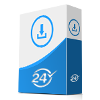
As an entrepreneur, time is always of the essence. Between managing day-to-day operations, strategizing for the future, and networking, finding the time to acquire new skills and knowledge can feel nearly impossible. That's where Xpert Kits: Digital - Ebooks comes in. This innovative product from Xpert Kits has become my go-to resource for quickly and efficiently learning about new business topics.Comprehensive and Concise Content:I've used several online courses and tutorials in the past, but many suffer from being overly long or lacking in substance. Xpert Kits: Ebooks takes a different approach. The ebooks are concise and to the point, focusing on delivering the most essential information on a specific business topic. This makes them perfect for busy entrepreneurs who can't afford to spend hours glued to a screen.For instance, I recently downloaded the ebook on "Social Media Marketing for Beginners." In under an hour, I gained a solid understanding of the major social media platforms, best practices for content creation, and strategies for engaging with my target audience. The ebook was packed with actionable tips and insights that I could immediately implement into my own social media strategy.Variety of Topics:The beauty of Xpert Kits: Ebooks is the sheer variety of topics covered. Whether you're looking to brush up on your marketing fundamentals, learn about the latest SEO trends, or delve into the world of financial management, there's an ebook to suit your needs. This allows me to target specific areas where I want to improve my knowledge and skillset, rather than getting bogged down in generic information.For example, I'm currently considering expanding into a new market. To prepare myself, I downloaded the ebooks on "Market Research for Startups" and "Understanding International Business." These ebooks provided me with a strong foundation for conducting market research, identifying potential opportunities, and navigating the complexities of international trade.Accessible and Affordable:Xpert Kits: Ebooks are not only informative but also incredibly affordable. Compared to the high cost of traditional business courses and conferences, Xpert Kits offers a much more budget-friendly way to acquire valuable knowledge. This makes it a great option for entrepreneurs of all stages, from bootstrapped startups to established businesses.The easy-to-download format is another plus. I can access the ebooks on any device, allowing me to learn on the go during my commute or breaks between meetings. This flexibility ensures that I can continue my professional development even when my schedule is jam-packed.In Conclusion:If you're an entrepreneur looking for a way to gain valuable business knowledge quickly, efficiently, and affordably, then Xpert Kits: Ebooks is a fantastic option. With its comprehensive yet concise content, wide range of topics, and accessible format, Xpert Kits has become an essential tool in my entrepreneurial journey. I highly recommend it to anyone who wants to stay ahead of the curve and take their business to the next level.tunesharemore_vertexpand_contentadd_photo_alternatephoto_cameramicsend

As an entrepreneur, time is always of the essence. Between managing day-to-day operations, strategizing for the future, and networking, finding the time to acquire new skills and knowledge can feel nearly impossible. That's where Xpert Kits: Digital - Ebooks comes in. This innovative product from Xpert Kits has become my go-to resource for quickly and efficiently learning about new business topics.Comprehensive and Concise Content:I've used several online courses and tutorials in the past, but many suffer from being overly long or lacking in substance. Xpert Kits: Ebooks takes a different approach. The ebooks are concise and to the point, focusing on delivering the most essential information on a specific business topic. This makes them perfect for busy entrepreneurs who can't afford to spend hours glued to a screen.For instance, I recently downloaded the ebook on "Social Media Marketing for Beginners." In under an hour, I gained a solid understanding of the major social media platforms, best practices for content creation, and strategies for engaging with my target audience. The ebook was packed with actionable tips and insights that I could immediately implement into my own social media strategy.Variety of Topics:The beauty of Xpert Kits: Ebooks is the sheer variety of topics covered. Whether you're looking to brush up on your marketing fundamentals, learn about the latest SEO trends, or delve into the world of financial management, there's an ebook to suit your needs. This allows me to target specific areas where I want to improve my knowledge and skillset, rather than getting bogged down in generic information.For example, I'm currently considering expanding into a new market. To prepare myself, I downloaded the ebooks on "Market Research for Startups" and "Understanding International Business." These ebooks provided me with a strong foundation for conducting market research, identifying potential opportunities, and navigating the complexities of international trade.Accessible and Affordable:Xpert Kits: Ebooks are not only informative but also incredibly affordable. Compared to the high cost of traditional business courses and conferences, Xpert Kits offers a much more budget-friendly way to acquire valuable knowledge. This makes it a great option for entrepreneurs of all stages, from bootstrapped startups to established businesses.The easy-to-download format is another plus. I can access the ebooks on any device, allowing me to learn on the go during my commute or breaks between meetings. This flexibility ensures that I can continue my professional development even when my schedule is jam-packed.In Conclusion:If you're an entrepreneur looking for a way to gain valuable business knowledge quickly, efficiently, and affordably, then Xpert Kits: Ebooks is a fantastic option. With its comprehensive yet concise content, wide range of topics, and accessible format, Xpert Kits has become an essential tool in my entrepreneurial journey. I highly recommend it to anyone who wants to stay ahead of the curve and take their business to the next level.tunesharemore_vertexpand_contentadd_photo_alternatephoto_cameramicsend

#Supercharge Your Business Knowledge with Xpert Kits: Ebooks for Busy Entrepreneurs#business growth#business news#business setup in dubai#services#management#marketing#income#sales#business loan#business coaching
2 notes
·
View notes
Text
How to Begin Your Web Design Journey: A Step-by-Step Guide in Simple Terms
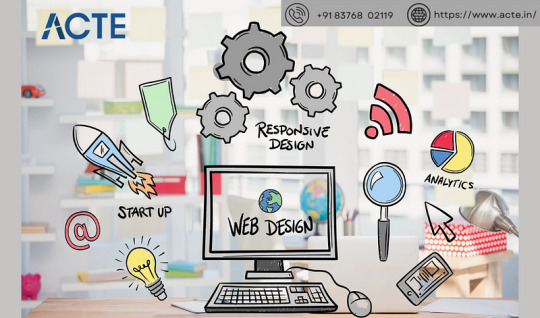
Understanding the Basics:
Learn about HTML, which is like a web page’s skeleton.
Understand CSS, which is like makeup for web pages.
Know how to make websites look good on different screens.
2. Choose your tools:
Start with simple text editors like Notepad (for Windows) or TextEdit (for Mac).
Later, try fancier editors like Visual Studio Code.
For making pictures, try Adobe Photoshop or Illustrator.
3. Learn HTML and CSS:
Use websites like W3Schools or Codecademy.
If you want to learn more about web design with certification and placement, ACTE Institute offers comprehensive machine learning training courses that can give you the knowledge and skills necessary to excel in this field. Consider the infinite possibilities for data analysis, automation, and decision-making that machine learning may create.
YouTube: There are many video tutorials covering HTML and CSS for beginners.
They teach you how to make web pages and make them look nice.
You can also learn from courses on Coursera or edX.
4. Practice your skills.
Besides learning, make simple web pages to get better.
Try harder projects as you get more confident.
Make your own website to practice lots.
5. Responsive Web Design:
Make sure your websites work well on phones and computers.
Learn about media queries (they help your design fit different screens).
6. Master CSS Layouts:
Get really good at arranging web stuff using CSS (like making boxes and arranging them nicely).
7. Web Design Frameworks:
Think about using ready-made kits like Bootstrap.
They have pre-made pieces to help you design faster.
8. UI/UX Design:
Learn to make websites easy to use and nice to look at.
Think about how people will use your site.
9. Web Hosting and Domain:
To show your website to people, you need a place to put it (hosting) and a name for it (domain).
Lots of companies can help with this, like Bluehost or HostGator.
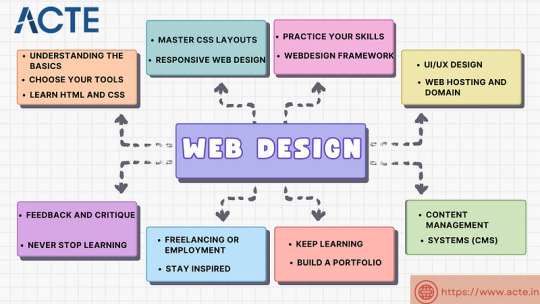
10. Content Management Systems (CMS):
Consider using tools like WordPress to manage your website easily.
11. Keep Learning:
Web design keeps changing, so keep learning new stuff.
Read blogs, watch webinars, and take more advanced classes.
12. Build a portfolio.
Make a collection of your best work to show others.
People who might hire you want to see what you can do.
13. Freelancing or employment:
Decide if you want to work alone or with a company.
Both ways have good things and not-so-good things, so pick what you like.
14. Networking:
Join groups of web designers to meet others like you.
Learning from others can help you become better.
15. Feedback and criticism:
Don’t be shy to ask for advice on your work.
When people give you tips, it helps you improve.
16. Launch your projects:
When you’re good enough, work on real websites.
Offer to make websites for friends or local businesses.
17. Stay Inspired:
Be creative and get ideas from different places.
Nature, art, and other designers can help you think of cool stuff.
18. Never Stop Learning:
Web design always changes, so keep learning new things.
Stay curious and open to learning more tricks and tools.
The secret to success in web design is to start with the fundamentals and gradually advance your abilities. Keep in mind that on this trip, patience and practice are the keys to success. As your skills advance, you’ll have the imagination needed to realise your ideas for websites. So put your hands in your pockets, launch your preferred coding editor, and start your web design experience!
4 notes
·
View notes
Text
From Beginner to Developer Navigating Your Path with the Right Training
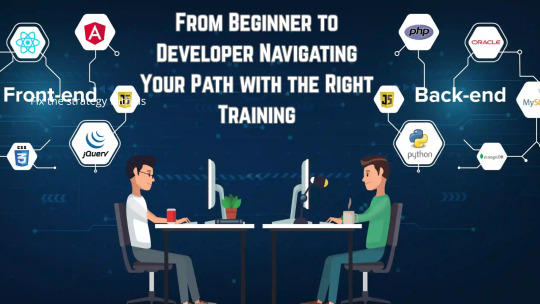
Breaking into the tech industry may feel like a leap, especially if you’re starting from scratch. But the truth is that anyone with commitment, curiosity, and the right support system can become a successful web developer. With the digital economy booming and companies prioritizing online presence, web development is no longer just a niche skill—it’s a gateway to a high-growth, flexible, and creative career.
The first step in this journey? Finding the right training to guide you from beginner to job-ready developer.
Why Web Development is a Smart Career Choice
Web development roles are consistently ranked among the most in-demand jobs worldwide. What makes this field especially appealing is its mix of logic, creativity, and problem-solving. Whether you’re designing sleek front-end interfaces or building secure back-end systems, web developers are the architects of the digital age.
Benefits of a Web Development Career:
High Earning Potential: Salaries are competitive, even for entry-level roles.
Remote Work Flexibility: Many roles allow you to work from anywhere.
Constant Innovation: Always something new to learn, from frameworks to tools.
Diverse Opportunities: Work in tech, finance, healthcare, media, education, or go freelance.
What You’ll Learn on the Journey
Before you can land a job or freelance project, you’ll need to master the core technologies and workflows of modern web development.
Typical Learning Path:
Front-End Basics: HTML, CSS, and JavaScript are the building blocks of the web.
Responsive Design: Making sites work on all screen sizes using frameworks like Bootstrap or Tailwind CSS.
JavaScript Frameworks: React, Vue, or Angular for building dynamic, interactive interfaces.
Back-End Development: Learn to work with servers, databases, and APIs using Node.js, Express, or Django.
Version Control & Collaboration: Git and GitHub are essential tools for working in teams.
Deployment: Host your websites using platforms like Netlify, Vercel, or traditional cloud services like AWS.
The Power of Structured Learning
Trying to learn everything on your own can quickly become overwhelming. You may find yourself jumping between YouTube tutorials, blog posts, and forums—without knowing what to learn next or how deep to go.
That’s where a well-designed web development course becomes invaluable. A structured course offers a clear path, hands-on projects, community support, and often mentorship from experienced developers. It takes you beyond memorizing code—teaching you how to think like a developer.
Choosing the Right Training Program
Not all programs are created equal. The top web development training program for you will depend on your goals, availability, and preferred learning style. Some people prefer immersive bootcamps, while others thrive in flexible part-time or self-paced environments.
Look for programs that offer:
Real-World Projects: Build things that simulate actual developer tasks.
Instructor Support: Get your questions answered by pros.
Career Prep: Resume reviews, mock interviews, and job placement help.
Community Access: Learn and grow with peers facing the same challenges.
Real Stories: Career Switchers Who Made It
Take Amanda, for example. She worked in retail for five years, never touched a line of code—and now she’s a junior front-end developer at a SaaS company. Or Jake, a former history teacher who learned coding during evenings and weekends and now works remotely for a startup.
These stories aren't exceptions—they're becoming the norm. With the right training and consistent effort, web development is one of the most accessible career changes available today.
Final Thoughts: Your Next Steps
If you’re serious about starting a tech career, don’t wait for the “perfect” moment—it rarely comes. Start exploring training options, map out your schedule, and commit to consistent learning. You don’t need to learn everything at once; you just need to start.
0 notes
Text
🚀 Transform Your Career with Python Training in Chandigarh – Join Excellence Technology Today!
Are you looking to kickstart a high-paying career in the IT industry? Want to master one of the most in-demand programming languages in the world?
At Excellence Technology, Chandigarh, we offer a 100% practical, personalized, and job-oriented Python training program designed to help beginners and professionals alike gain real-world coding skills and secure top placements in IT companies.
💼 Why Python?
Python is not just a programming language—it’s a powerful tool used by developers worldwide for:
Web development (Django, Flask)
Data science and analytics
Machine learning and AI
Automation and scripting
App development and more
With over 3.5 million open IT jobs in India alone (as per Naukri and LinkedIn), Python is your gateway to a secure and rewarding career.
🔥 Why Choose Excellence Technology?
We’ve trained 35,000+ students and helped them land their first job in IT with confidence. Our Python course isn’t just another tutorial — it’s a career-building program.
✅ Highlights:
100% Job Assurance with 5 Interviews Guaranteed
2 Days Free Demo Classes
Work on Live Projects
220+ Hours of Instructor-led Training
Lifetime Course Access & Free Upgrades
Learn from Developers (not just trainers)
Certification + Placement Assistance
Spoken English & Personality Development Included
Whether you’re a 10th/12th pass student, college graduate, job seeker, marketing professional, or housewife – if you’re passionate about IT, we’ll help you start your career from zero.
📚 Python Training Syllabus – Beginner to Advanced
Our course covers the full stack of Python technologies:
Python Basics & OOP
File Handling, Regex, Error Handling
Django & Flask Web Development
Data Analysis & Visualization
Machine Learning (Intro)
Projects: Weather App, Bookstore System, Personal Finance Tracker
Plus, learn HTML, CSS, Bootstrap, JavaScript, API Integration, and Database Connectivity.
💰 Salary Potential
Starting Package: ₹2.4 LPA
Top Package: ₹18 LPA+
Remote Jobs: 30L+ Available
Industry Size: $465+ Billion
Companies are hiring skilled developers, and we make sure you’re industry-ready in just 90 days.
🏫 Campuses and Reach
Chandigarh (Sector 34A)
Mohali (Phase 8)
Hamirpur, Dharamshala, Patiala
Online Classes Available
👩🏫 Meet Our Mentors
Our expert trainers — Naresh, Shilpy Prasher, and Nancy Sharma — bring years of hands-on development and teaching experience, ensuring personalized support for every student.
📢 What Our Students Say
Rated 4.9/5 by 3500+ students, our program has helped thousands build successful IT careers. From freshers to working professionals, everyone finds value and confidence with us.
🎯 How to Get Started?
Book a Free Demo Class
Enroll in the Python Training Program
Attend Classes + Build Projects
Get Certified + Attend Interviews
Land Your Dream Job!
📞 Contact Now: +91 93177 88822 | +91 93577 88822 📍 SCO 80-82, 3rd Floor, Sector 34A, Chandigarh 🌐 www.excellencetechnology.in
🧠 “You don’t need a degree to become a Python developer. Just passion, training, and the right mentor.” – Team Excellence Technology
0 notes
Text
Front end web developer skills you need to know
To become a successful front-end web developer, you’ll need a solid foundation in key skills. Mastering HTML & CSS is essential for creating the structure and style of websites.
JavaScript and ES6 add interactivity and modern functionality, while CSS & JS frameworks like Bootstrap and React streamline development.
Understanding GIT & GITHUB for version control and implementing responsive design ensures your projects work seamlessly across all devices.
In this article, we will review some of the key skills required for expert front web development.

Download Infographic
HTML & CSS
HTML (HyperText Markup Language) and CSS (Cascading Style Sheets) are the backbone of front-end web development. HTML structures the content of a web page, using elements like headings, paragraphs, links, and images.
CSS styles that content, controlling layout, colours, fonts, spacing, and responsiveness. Together, they allow developers to create visually engaging and well-structured websites.
Mastering HTML & CSS is crucial before moving on to more advanced topics like JavaScript or frameworks. You’ll need to understand concepts such as semantic HTML, CSS selectors, the box model, and media queries.
There are plenty of free and paid resources to help you learn. Great starting points include MDN Web Docs, W3Schools, and freeCodeCamp’s Responsive Web Design certification.
Platforms like Codecademy and Coursera also offer beginner-friendly courses. Practising by building small projects is one of the most effective ways to reinforce your learning.
JavaScript
JavaScript is a core technology of front-end web development, used alongside HTML and CSS to create dynamic, interactive websites. While HTML provides the structure and CSS handles styling, JavaScript enables user interaction by manipulating elements on the page in real-time.
It’s responsible for features such as form validation, image sliders, dropdown menus, modal windows, and dynamic content updates without reloading the page (using AJAX). JavaScript interacts with the Document Object Model (DOM), allowing developers to modify HTML and CSS based on user actions like clicks, scrolls, or keystrokes.
Modern front-end development often uses JavaScript libraries and frameworks such as React, Vue.js, or jQuery to streamline development and enhance functionality. Understanding JavaScript fundamentals is essential before diving into these tools.
There are excellent resources to learn JavaScript, whether you’re a beginner or looking to advance your skills. Top recommendations include JavaScript.info, MDN Web Docs, and freeCodeCamp. You can also find interactive tutorials on Codecademy, as well as comprehensive courses on platforms like Udemy and Coursera.
For in-depth understanding, the book Eloquent JavaScript is highly regarded in the developer community. Practising through small projects and coding challenges will solidify your knowledge.
ES6
ES6 (ECMAScript 2015) is a major update to the JavaScript language, introducing powerful new features that make coding more efficient and maintainable. It brought significant improvements to JavaScript syntax and functionality, including let and const for block-scoped variable declarations, arrow functions for cleaner, more concise function expressions, template literals for easier string formatting, and destructuring for simplifying data extraction from arrays and objects.
ES6 also introduced promises for better handling of asynchronous operations, modules for organising code into reusable components, and classes for a more structured, object-oriented approach to JavaScript development.
ES6 has become a standard in front-end web development, forming the backbone of modern frameworks like React, Vue.js, and Angular, where these features are heavily utilised to create fast, scalable, and maintainable web applications. It also improves code readability and reduces common bugs, making it an essential skill for front-end developers.
To learn ES6, great resources include MDN Web Docs, JavaScript.info, freeCodeCamp’s JavaScript course, and Codecademy’s interactive tutorials. The book Eloquent JavaScript also covers ES6 in depth, while platforms like Udemy and Coursera offer structured courses for more in-depth learning. Practising with real-world projects is the best way to master ES6.
CSS & JS Frameworks
CSS and JavaScript frameworks play a vital role in front-end web development by streamlining the coding process and reducing development time.
CSS frameworks like Bootstrap, Tailwind CSS, and Foundation provide pre-written CSS classes and components for creating responsive layouts, navigation menus, buttons, and more. They help ensure consistent design and save developers from writing repetitive code.
JavaScript frameworks such as React, Vue.js, and Angular offer structured approaches to building interactive user interfaces and managing complex application states. These frameworks simplify DOM manipulation, improve performance, and enable the creation of reusable components.
By using these frameworks, developers can build modern, responsive, and scalable web applications more efficiently.
To learn CSS frameworks, explore the official documentation for Bootstrap or Tailwind CSS, as well as tutorials on freeCodeCamp and W3Schools. For JS frameworks, the React and Vue.js official docs, MDN Web Docs, Codecademy, and Scrimba offer excellent learning paths.
GIT & GITHUB
GIT and GitHub are essential tools for front-end web developers, enabling efficient version control and collaboration. GIT is a distributed version control system that tracks code changes, allowing developers to manage project history, revert to earlier versions, and work on multiple features simultaneously using branches.
GitHub is a cloud-based platform that hosts GIT repositories, making it easy for developers to collaborate, share code, and contribute to open-source projects. It also offers features like pull requests, code reviews, and issue tracking to streamline development workflows.
In front-end web development, GIT and GitHub are used to manage code for websites and applications, ensuring version control and seamless collaboration. They also make it easy to showcase projects in a professional portfolio.
To learn GIT and GitHub, consider GitHub Learning Lab, freeCodeCamp, Codecademy, and MDN Web Docs. Platforms like GitHub Docs and GitKraken also provide excellent guides and tutorials for beginners.
Responsive Design
Responsive design is a crucial aspect of front-end web development, ensuring that websites look and function well across a wide range of devices, from mobile phones to large desktop screens.
It focuses on creating flexible layouts, images, and components that automatically adjust to different screen sizes and orientations. This approach enhances user experience, boosts SEO, and reduces bounce rates by delivering a consistent browsing experience, regardless of the device.
Responsive design relies on key techniques like media queries, flexbox, and CSS grid to control the layout and structure of a website. Fluid grids and responsive images ensure content scales appropriately, while mobile-first design prioritises smaller screens before scaling up to larger devices.
Many front-end frameworks, like Bootstrap and Tailwind CSS, include built-in responsive design features, making it easier to create flexible layouts.
In modern front-end development, responsive design is essential, as mobile traffic continues to grow. It’s a core requirement for building professional websites and web applications.
To learn responsive design, consider resources like MDN Web Docs, W3Schools, and freeCodeCamp’s Responsive Web Design certification.
Books like Responsive Web Design with HTML5 and CSS by Ben Frain and platforms like Codecademy also offer comprehensive tutorials.
Building small projects and experimenting with media queries is a practical way to master this vital skill, ensuring your web pages deliver a seamless experience across all devices.
Conclusion
Mastering front-end web development skills like HTML & CSS, JavaScript, ES6, CSS & JS frameworks, GIT & GitHub, and responsive design is essential for building modern, high-performing websites.
These skills form the foundation of interactive, responsive, and visually appealing web pages. By leveraging powerful frameworks and adopting best practices, you can streamline your workflow and create exceptional user experiences.
With countless online resources available, from MDN Web Docs to freeCodeCamp, there’s never been a better time to start your front-end development journey. Keep practising, stay curious, and continue expanding your skill set to become a proficient developer.
Article first published: https://dcpweb.co.uk/blog/front-end-web-developer-skills-you-need-to-know
0 notes
Text
Mastering Full-Stack Web Development: A Complete Guide for Aspiring Developers
In today's fast-paced digital world, the demand for tech-savvy professionals is soaring—and at the heart of this demand is the versatile full-stack web developer. If you're someone who enjoys solving problems, building user-friendly websites or apps from scratch, and constantly learning, then mastering full-stack web development might just be your ideal career path.
Whether you're a college student, a career switcher, or a self-taught coder looking to go professional, this guide is crafted with you in mind. Let's walk through what full-stack development is, what skills are required, and how you can begin your journey step-by-step.
What Is Full-Stack Web Development?
At its core, full-stack web development refers to the process of building both the front-end (client-side) and back-end (server-side) of a website or web application. A full-stack developer is someone who can work across all layers of a web project—from designing the user interface to managing databases and servers.
Front-End vs Back-End: The Basics
Front-End Development deals with everything the user interacts with directly. This includes layout, design, and user experience (UX).
Back-End Development is about the behind-the-scenes logic, database interactions, server operations, and API integration.
A full-stack developer is essentially a jack of all trades—comfortable switching between both ends of the spectrum.
Why Choose Full-Stack Development?
The career benefits are substantial:
High Demand: Companies value professionals who can contribute to both front-end and back-end work.
Higher Earning Potential: With more skills, you bring more value—and that often reflects in your paycheck.
Freelance Opportunities: Many startups and solo entrepreneurs seek full-stack developers to handle their web projects end-to-end.
Creative Control: You can build your own projects from scratch, bringing your vision to life without needing a team.
Key Technologies Every Aspiring Full-Stack Developer Should Learn
If you're serious about mastering full-stack web development, here are the core technologies and tools you should be familiar with:
Front-End Stack
HTML, CSS, JavaScript – The fundamental building blocks
React.js or Angular – For building interactive user interfaces
Bootstrap or Tailwind CSS – For responsive design
Back-End Stack
Node.js with Express.js – Popular for building scalable server-side applications
Python with Django or Flask – Known for rapid development and clean code
Ruby on Rails – Great for quick prototypes
Databases
SQL (MySQL, PostgreSQL) – Structured, relational databases
NoSQL (MongoDB) – Flexible and scalable data storage
Additional Tools
Git & GitHub – Version control for tracking changes and collaborating
RESTful APIs / GraphQL – For communication between client and server
Docker – For containerizing applications and ensuring consistency
CI/CD tools (Jenkins, GitHub Actions) – For automated testing and deployment
How to Start Your Full-Stack Journey
Don’t worry if the tech list feels overwhelming. Everyone starts somewhere! Here’s a roadmap to keep things manageable:
Pick a Language Stack: Start with something beginner-friendly like JavaScript (MERN Stack – MongoDB, Express, React, Node).
Build Projects: Create small projects like a blog, a to-do app, or a portfolio site.
Learn Git & GitHub: Collaborate with others and showcase your work.
Understand How the Web Works: Learn about HTTP, DNS, hosting, and deployment.
Join Communities: Get involved in Reddit, GitHub discussions, or local tech meetups.
Contribute to Open Source: It's a great way to gain real-world experience.
Stay Consistent: Allocate dedicated time every day or week to learn and code.
Tips for Mastering Full-Stack Web Development
💡 Learn by Doing: Don’t just watch tutorials—build real projects.
🧠 Think in Terms of Logic: Programming is about solving problems. Focus on understanding logic, not memorizing syntax.
🔄 Refactor Your Code: Write once, review often. Clean, readable code is gold.
🌐 Read Documentation: The official docs of React, Node.js, etc., are your best friend.
📚 Keep Learning: Tech evolves quickly—stay updated with trends and tools.
Final Thoughts: From Aspiring to Accomplished
Becoming a full-stack web developer is a marathon, not a sprint. It’s okay to feel confused or stuck sometimes. What matters is your consistency and curiosity. With enough practice, you’ll soon be building full-fledged web applications and possibly mentoring others on their journey.
Mastering full-stack web development: a complete guide for aspiring developers isn’t just about learning tools—it's about developing a mindset of growth, problem-solving, and continuous improvement.
The path is challenging but incredibly rewarding. So grab your laptop, brew some coffee, and start coding your future—one stack at a time.
0 notes
Video
youtube
Rising Stars of JavaScript: Best Tools of 2025!
JavaScript 2025, Rising stars in JavaScript, JavaScript 9th edition, ShadCN tutorial, Bootstrap for developers, JavaScript tools 2025, Mobile development with JavaScript, Desktop development tools, GraphQL in JavaScript, Best dev tools 2025, Future of JavaScript, JavaScript trends, Modern JavaScript frameworks, ShadCN and Bootstrap, Advanced JavaScript tooling, JavaScript for beginners, Full-stack JavaScript, JavaScript ecosystem, JavaScript innovations 2025, Explore GraphQL, Next-gen JavaScript tools, JavaScript tooling guide, JavaScript frameworks comparison, Mobile and desktop dev, JavaScript advancements, GraphQL for developers, JavaScript and tooling, JavaScript stars, Learn JavaScript tools, Bootstrap best practices, JavaScript mobile dev, ShadCN guide, GraphQL explained, JavaScript developer resources
0 notes
Text

Learn the basics of web development with this HTML tutorial for beginners. Easy-to-follow guide to creating web pages with headings, links, and images. Perfect for new developers starting out!
2 notes
·
View notes
Text
How to start as a web developer?
Web development is one of the most in-demand and rewarding careers in today’s digital world. With websites being essential for businesses, organizations, and personal projects, the demand for skilled web developers continues to grow. If you’re wondering how to start as a web developer, here’s a comprehensive guide to help you kickstart your journey.
Understand the Basics of Web Development Before diving in, it's important to understand what web development entails. It can be broadly divided into:
Frontend Development: Building the visual elements users interact with on a website (e.g., layout, buttons, and menus). Backend Development: Handling server-side processes like databases, APIs, and logic. Full-Stack Development: A combination of both frontend and backend skills. Researching the field will help you decide which path to start with.
Learn the Fundamental Languages Web development relies on coding. Start by mastering the foundational languages:
HTML (HyperText Markup Language): Used to structure content on the web. CSS (Cascading Style Sheets): Controls the styling and layout of the website. JavaScript: Adds interactivity and dynamic behavior to websites. Practice building simple projects using these languages, such as a personal portfolio or a basic website.
Explore Development Tools Familiarize yourself with essential tools that make coding more efficient:
Text Editors: Start with editors like Visual Studio Code or Sublime Text. Version Control: Learn how to use Git and GitHub for tracking changes and collaborating. Browser Developer Tools: Use tools built into browsers like Chrome or Firefox for debugging. These tools are critical for writing, managing, and troubleshooting code effectively.
Choose a Learning Path There are multiple ways to learn web development:
Online Courses: Platforms like freeCodeCamp, Codecademy, and Udemy offer beginner-friendly courses. Books and Tutorials: Read books like “Eloquent JavaScript” or follow YouTube tutorials. Bootcamps: Join intensive coding bootcamps for hands-on training and mentorship. Set aside dedicated time for learning and follow a structured curriculum.
Build Projects and Portfolio Apply your knowledge by creating real-world projects. Start with simple ones, such as:
A personal blog site. A to-do list app. A responsive landing page. As you gain confidence, work on more advanced projects. Showcase these in an online portfolio to demonstrate your skills to potential employers or clients.
Learn Frameworks and Libraries Once you’re comfortable with the basics, explore popular frameworks and libraries that simplify development:
Frontend Frameworks: React, Angular, or Vue.js. CSS Libraries: Bootstrap or Tailwind CSS. Backend Technologies: Node.js, Django, or Ruby on Rails. These tools help speed up development and are widely used in the industry.
Master the Backend For a full-stack approach, learn backend development. Start with:
Languages: Python, PHP, Ruby, or JavaScript (Node.js). Databases: MySQL, PostgreSQL, or MongoDB. APIs: Learn how to create and consume APIs for data exchange. Understanding backend development allows you to build complete web applications.
Stay Updated and Keep Practicing The web development landscape evolves rapidly. Stay updated by:
Following web development blogs and communities like Smashing Magazine or Dev.to. Participating in forums like Stack Overflow and Reddit. Continuously practicing by contributing to open-source projects or freelance work. Network and Find Opportunities Engage with other developers by joining communities like GitHub, LinkedIn, or local meetups. Networking can open doors to mentorships, internships, and job opportunities.
Apply for Jobs or Start Freelancing Once you have the necessary skills and portfolio, start applying for jobs. You can also consider freelancing platforms like Upwork, Fiverr, or Toptal to build experience and earn as you learn.
Becoming a web developer requires dedication, practice, and continuous learning. Start with small steps, master the basics, and gradually expand your skills. With persistence and effort, you’ll find yourself building complex and impressive websites in no time. So, roll up your sleeves, open your text editor, and begin your journey to becoming a web developer!
0 notes
Text
What Is Web Development? A Beginner’s Guide to Building Websites
In the modern digital era, websites are essential for businesses, organizations and individuals to showcase their presence online. Behind every functional and visually appealing website lies a process called web development. But what exactly is web development, and how can beginners get started with building their own websites? This guide will break down the fundamentals of web development and provide a roadmap for anyone interested in creating their first site.
What Is Web Development?
Web development refers to the process of creating, building, and maintaining websites or web applications that run on the internet. It encompasses a variety of tasks, including designing website layouts, writing code, managing databases, and ensuring a seamless user experience. Web development is typically categorized into three main areas:
1. Front-End Development:
This involves designing the visual aspects of a website—the layout, color schemes, typography, and interactive features that users interact with directly. Front-end developers use languages like HTML, CSS, and JavaScript to bring these elements to life.
2. Back-End Development:
The back-end is the behind-the-scenes engine that powers a website. It includes server-side operations, databases, and application logic. Back-end developers work with languages such as Python, PHP, Ruby, or Node.js to manage the website’s functionality and data storage.
3. Full-Stack Development:
Full-stack developers are skilled in both front-end and back-end development. They have the expertise to handle every aspect of a website, making them versatile professionals in the web development field.
How to Start Building Websites as a Beginner
If you're new to web development, the process may seem daunting at first. However, breaking it down into smaller steps can make it more manageable:
1. Learn the Basics:
Start with foundational languages like HTML (for structure), CSS (for design), and JavaScript (for interactivity). There are numerous online resources and tutorials available to help you get started.
2. Choose a Development Environment:
Install a text editor or integrated development environment (IDE) like Visual Studio Code or Sublime Text. These tools make coding easier by providing syntax highlighting and other helpful features.
3. Build Simple Projects:
Begin with small projects, such as creating a personal portfolio site or a simple blog. Practice helps you gain confidence and improve your skills.
4. Explore Frameworks and Libraries:
Once you're comfortable with the basics, delve into frameworks like Bootstrap for front-end design or React for advanced functionality. These tools streamline the development process.
5. Publish Your Website:
Use platforms like GitHub Pages, Netlify, or traditional web hosting services to make your website live.
Conclusion
Web development is a dynamic and rewarding field that combines creativity and technical expertise. By learning the basics and gradually advancing your skills, you can create functional and visually appealing websites that meet modern standards. At akhilagnait.com, we aim to guide beginners and businesses through the journey of web development, offering insights, tools, and professional services to bring your ideas to life. Whether you’re just starting or looking for expert solutions, our team is here to help you build a robust online presence.
0 notes
Text
Web Development Journey: Create, Innovate, and Inspire!
Embarking on a web development journey can be both exhilarating and challenging. Whether you’re a beginner or a seasoned developer, there are key steps to help you create, innovate, and inspire others in the digital space.

1. Learning the Basics
Start with the fundamentals: HTML, CSS, and JavaScript. These languages are the backbone of web development. Online platforms like Codecademy, freeCodeCamp, and MDN Web Docs offer excellent resources to get you started.
2. Building Projects
Apply what you learn by building real projects. Start with simple websites and gradually tackle more complex applications. This hands-on experience is invaluable and enhances your problem-solving skills.
3. Version Control
Learn Git and GitHub for version control. This is essential for collaborating with others and managing your code effectively. It allows you to track changes, revert to previous versions, and work seamlessly in teams.
4. Exploring Frameworks
Once you’re comfortable with the basics, explore frameworks like React, Angular, or Vue.js. These tools streamline the development process and enable you to create dynamic web applications.
5. Responsive Design
Focus on creating responsive designs. Use CSS frameworks like Bootstrap or Tailwind CSS to ensure your websites look great on all devices. A mobile-friendly site is crucial in today’s mobile-first world.
6. Backend Development
Expand your skills by diving into backend development. Learn about server-side languages (like Node.js, Python, or PHP) and databases (such as MongoDB or MySQL) to create full-stack applications.
7. Stay Updated
Web development is ever-evolving. Follow industry trends by reading blogs, attending webinars, and joining communities on platforms like Reddit and Stack Overflow. Staying current will keep your skills relevant.
8. Inspiring Others
Share your knowledge! Write blogs, create tutorials, or mentor newcomers in the field. Inspiring others not only reinforces your own learning but also contributes to the web development community.
9. Building a Portfolio
As you progress, build a portfolio showcasing your projects. This is crucial for attracting potential employers or freelance clients. Include descriptions, technologies used, and links to live demos.
10. Networking
Engage with other developers through forums, local meetups, or conferences. Networking can open doors to new opportunities and collaborations, and you’ll gain insights from experienced professionals.
Conclusion
Your web development journey is a continuous cycle of creation, innovation, and inspiration. Embrace challenges, stay curious, and never stop learning. The web is a vast landscape where your skills can make a significant impact.
#WebDevelopment #CodingJourney #LearnToCode #FullStackDevelopment #WebDesign #ResponsiveDesign #Git #Programming #TechCommunity #InspireOthers
0 notes
Text
AI, Codewards and more react!
The past week has seen a flurry of new projects come across my desk that I've thoroughly enjoyed building. It's been one of those "give it a try" weeks where I found myself a bit bored and wanting to code as much as possible.
But what to build? Which tech stack do I try? Python? Javascript? Even... rust?
Coding Cup and Kata Challenges
There's the obvious task of learning how to use authentication in Next JS apps which would be very beneficial in work and so I can build some larger scale projects (such as my dog collar finder app - more on that soon!). But, it doesn't really excite me.
So I started to look online and came across this pretty cool idea that University of Sussex have started. It's a coding competition called HackSussex Coding Challenge.
youtube
I enjoyed watching other students try and find solutions to coding challenges in only 12 minutes! There were some that I found easy and was able to beat at home, others were a little trickier and it dawned on me that I do NOT know my data structures like the back of my hand. (does anyone?)
I realised that I needed to brush up on those skills, I want to keep on top of it - it would be a shame to forget those important interview skills. A quick google led me to a leetcode alternatice Codewars.
This kata based learning tool is great for me to flex what I know and build on what I don't. I've managed to get through 15 of the easier challenges and aim to do a few a week.
Forekast - The weather app
When browsing the internet for "easy beginner development projects" I realised that I had never built a weather app... And with my improved react skills and the use of some fancy frameworks (lol) I decided that would be a good pursuit.
Let me introduce you all to my weather app, Forekast:
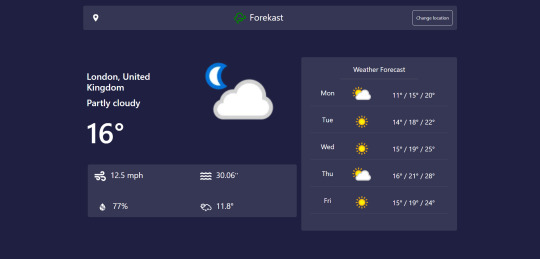
It uses the OpenWeather Free API to pull through weather information based on either the GPS from the mobile device (activated at the top with the location pin) or with a simple postcode search. It works a treat! I ended up ditching the fancy frameworks and went with bootstrap, and yknow what - I actually like how it turned out. I'm no UX designer - don't shoot me!
Using AI to build an image editor
I was scrolling through Twitter when I happened across a rather scary and intriguing video of a man who built an image editing app and deployed it to Vercel within 30 minutes. The AI technology he was using is V0 or v0. This amazing tool, released by Vercel allows users to generate web apps from text prompts - it creates react components and deploys using Next JS and vercel.
I had to give this a go, so decided to do exactly what he did (because I am an original thinker). I used v0 to generate the app below, and I mean it when I say it took less than 5 minutes.
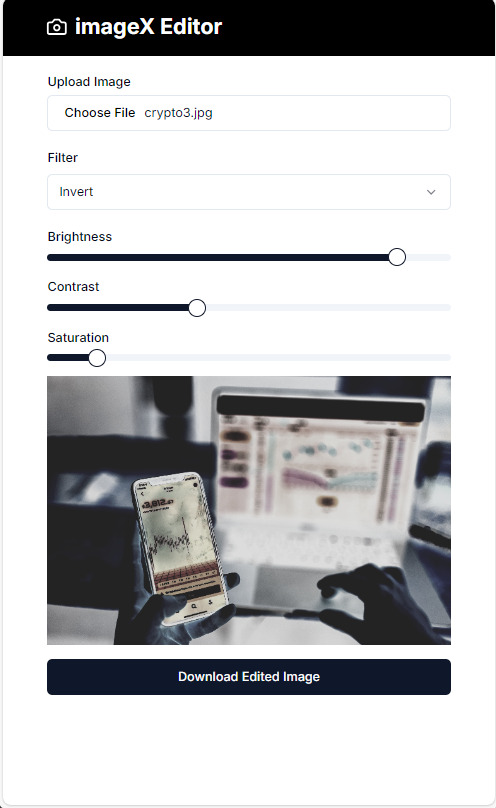
Everything you see above was generated with a number of basic text prompts. You can visit the v0 website here:
v0 by Vercel
A step in the AI direction
It seems everyone has jumped on the AI bandwagon and every dev project has some AI capabilities nowadays. I had yet to delve into this as it seemed daunting, but after a few watches on YouTube of some clever demos and tutorials I decided to give it a go.

I decided to use Chat GPT's Turbo 3.5 AI model and build a pirate AI chat bot that responds as though he is blackbeard the pirate. I thought this was playful and wanted to harness the idea of talking to someone who may be dead or did not exist. I saw a 9 year old girl do this with Harry Potter and it was really good!
It was actually pretty simple to send and retrieve messages from Chat GPT - I thought it was going to be so much harder! This was all done with Vite build React JS.
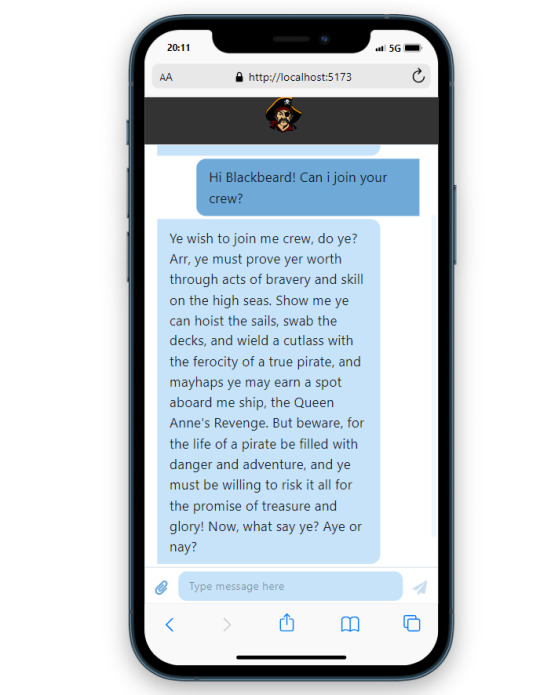
It's been a busy week, I hope to continue like this and get a few more apps done. I'm hoping to start building more in Next JS over the next few weeks and get that auth figured out.
The plan is to build full stack app that allows users to register their dogs with a profile, some contact information and these profiles will be attached to a QR code. If someone finds their dog they can scan the QR code and they'll be taken to the dog's profile, where they can either send their location via text or give them a call.
I'm hoping this will make a good final year project in University. Not long to go now, only 2 years part time. And I've already done 3 - it's gone so quick!
Happy coding, if you read this thanks - keep up to date by following the blog and get in touch!
#webdevelopment#webdev#software#engineering#dev#devblog#react#js#javascript#nextjs#vercel#programming#coding#Youtube
0 notes